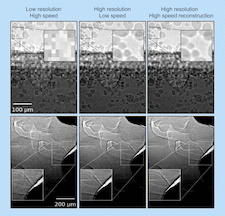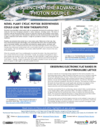issue contents
March 2025 issue

Cover illustration: Deep learning-based reconstruction of high-resolution and high-speed X-ray videos for high-speed imaging: (left) selected low-resolution, high-speed video frames of 4 times larger pixel size, (middle) selected high-resolution, low-speed video frames of 20 times larger frame separation, (right) selected high-resolution, high-speed video frame reconstruction (see Tang, Bicer, Sun, Fezzaa and Clark, pages 432–441). The results show that the new method can significantly improve the reconstruction, achieving an average peak signal-to-noise ratio of more than 35 dB on the two representative X-ray image sequences.
facility information
research papers
 access
access access
access access
access access
access access
access access
access access
access access
access access
access access
access access
access access
access access
access access
access access
access access
access access
access access
access access
accessA deep learning-based algorithm is developed and evaluated that demonstrates the potential to reconstruct simultaneously high-resolution high-frame-rate X-ray image sequences with high fidelity through spatio-temporal fusion. Experimental evaluation shows that the method can significantly improve the accuracy of the reconstruction, achieving an average peak signal-to-noise ratio (PSNR) of more than 35 dB on two representative X-ray image sequences with input data streams of four times lower spatial resolution and 20 times lower frame rate, respectively.
 access
accessbeamlines
 access
access access
access access
access access
accesscomputer programs
 access
access
 journal menu
journal menu













































